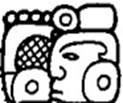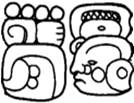
![]()


K&L.p23.pdfp23.#4.1&2 TOK.p23.pdfp23.r1.c1 BMM9.p14.r2.c4 25EMC.pdfp51.#7.1&2
XIB XIB XIB XIB

![]()


Looper Looper Looper Looper
QRG Stela A C8 QRG Stela D B18b QRG Stela D D22b (top) QRG Stela F C8b-D8a / A8b-B8a
4:<<TE’:IHK’>.XIB> <4:TE’>:<IHK’.XIB> <4:IHK’>.<TE’:XIB> <4:TE’> <IHK’:XIB>
· No glyphs given in K&H.
· There two listings for xib in EB.p203.pdfp208.#9
 referencing the Dresden Codex, but I have been unable to locate them as I don’t understand the referencing system (63, 22C-2,3) used:
o EB.p203.pdfp208.#9: xib (1) n. “young man” XIB-bi > xib Dresden 63.
o EB.p203.pdfp208.#10: xib (2) n. “fear, fright” xi-bi > xib Dresden 22C-2,3.
· The meaning “young man” is given only in EB.
o K&L.p23.pdfp23.#4: “person, man”.
o BMM9.p120.pdfp54.#11: “person, man”.
o 25EMC.pdfp51.#7: “person, man”.
It is however worth noting that the iconography of the glyph itself shows a young(er) man rather than an old(er) one.
o The other xib2 with the meaning “fear” appears to be just a homonym and the fact that they’re pronounced the same is probably just a coincidence. There is probably a connection between xib2 with the meaning “fear” and Xibalba = “the Underworld” (though this appears to be a term from after the Classic period).
· The four examples of Chan Te’ Ihk’ Xib given above are part of the extended name of K’ahk’ Tiliw Chan Yopaat – the ruler of QRG who captured and executed his overlord, Waxak Lajuun Ubaah K’awiil (a.k.a “18 Rabbit”), the ruler of CPN who actually oversaw the former’s accession. The order of writing the glyphs in QRG Stela D D22b (top) is slightly irregular (CHAN-IHK’-TE’-XIB) but the other three examples clearly show the correct order of reading (CHAN-TE’-IHK’-XIB).